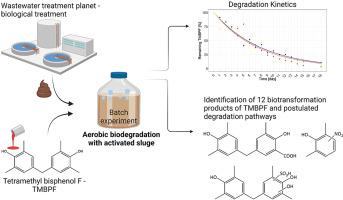Environmental Research ( IF 7.7 ) Pub Date : 2023-03-31 , DOI: 10.1016/j.envres.2023.115790 Ana Kovačič 1 , Martin Rafael Gulin 1 , Christina Nannou 2 , Lelouda-Athanasia Koronaiou 3 , Tina Kosjek 4 , David Heath 1 , Mark S Maier 5 , Dimitra Lambropoulou 3 , Ester Heath 4

|
This study investigated the bio-degradation kinetics of tetramethyl bisphenol F (TMBPF), a non-estrogenic alternative to bisphenol A (BPA). Batch biotransformation experiments were performed whereby samples were inoculated with activated sludge and analysed using liquid chromatography-Orbitrap-tandem mass spectrometry (LC-Orbitrap-MS) utilising two non-targeted workflows (commercial and freely available online) for biotransformation products (BTP) identification. The degradation of TMBPF followed single first-order reaction kinetics and depended on the initial concentration (ci) with faster degradation -kt = 0.16, (half-life = 4.4 days) at lower concentrations ci = 0.1 mg L−1, compared with -kt = 0.02 (half-live = 36.4 days) at ci = 10.0 mg L−1. After 18 days, only 8% of the original TMBPF remained at the lowest tested concentration (0.1 mg L−1). Twelve BTPs were identified, three of which were workflow and one condition-specific. The highest relative quantities of BTPs were observed in nutrient-mineral and mineral media after ten days, while after 14 days, 36 and 31% of TMBPF (ci = 1 mg L−1) remained in the nutrient-mineral and mineral media, respectively. Also, the kinetics of TMBPF and its BTPs were the same with and without an additional carbon source. A newly proposed biodegradation pathway for TMBPF involves cleavage of the methylene bridge, hydroxylation with further oxidation, sulphation, nitrification, nitro reduction with further oxidation, acetylation, and glycine conjugation, providing a deeper insight into the fate of TMBPF during biological wastewater treatment.
中文翻译:

活性污泥对四甲基双酚 F (TMBPF) 的好氧降解:动力学和生物转化产物
本研究调查了四甲基双酚 F (TMBPF) 的生物降解动力学,TMBPF 是双酚 A (BPA) 的一种非雌激素替代品。进行了批量生物转化实验,将样品接种活性污泥,并使用液相色谱-Orbitrap-串联质谱法 (LC-Orbitrap-MS) 进行分析,利用两种非靶向工作流程(商业和免费在线提供)进行生物转化产物 (BTP) 鉴定. TMBPF 的降解遵循单一的一级反应动力学,并取决于初始浓度 (ci ),降解速度更快 -k t = 0.16,(半衰期 = 4.4 天)在较低浓度 c i = 0.1 mg L −1,与 -k t相比 = 0.02(半衰期 = 36.4 天)在 c i = 10.0 mg L −1时。18 天后,只有 8% 的原始 TMBPF 保持在最低测试浓度 (0.1 mg L -1 )。确定了 12 个 BTP,其中三个是工作流程,一个是条件特定的。十天后,在营养矿物质和矿物质培养基中观察到 BTP 的相对数量最高,而在 14 天后,TMBPF 的 36% 和 31% (ci = 1 mg L -1) 分别保留在营养矿物质和矿物质培养基中。此外,TMBPF 及其 BTP 的动力学在有和没有额外碳源的情况下是相同的。新提出的 TMBPF 生物降解途径涉及亚甲基桥的裂解、羟基化和进一步氧化、硫酸化、硝化、硝基还原和进一步氧化、乙酰化和甘氨酸结合,从而更深入地了解 TMBPF 在生物废水处理过程中的命运。













































 京公网安备 11010802027423号
京公网安备 11010802027423号